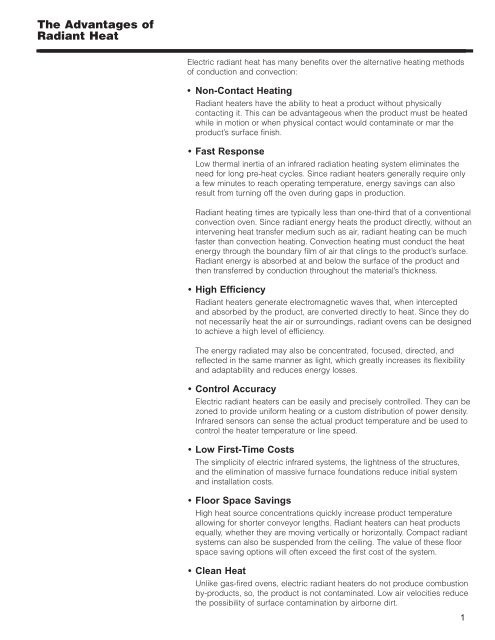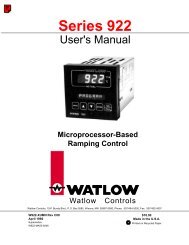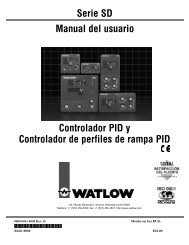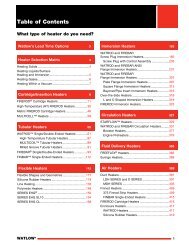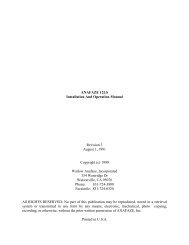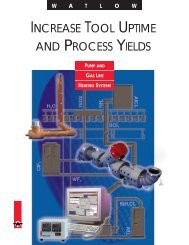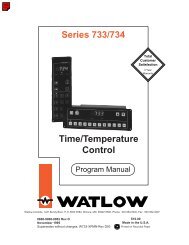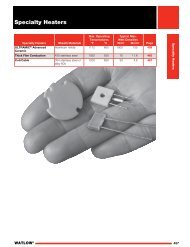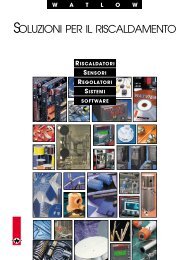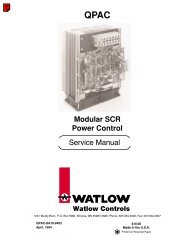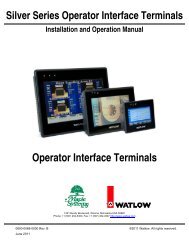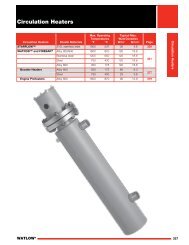RADIANT HEATING WITH INFRARED - Watlow
RADIANT HEATING WITH INFRARED - Watlow
RADIANT HEATING WITH INFRARED - Watlow
Create successful ePaper yourself
Turn your PDF publications into a flip-book with our unique Google optimized e-Paper software.
The Advantages of<br />
Radiant Heat<br />
Electric radiant heat has many benefits over the alternative heating methods<br />
of conduction and convection:<br />
• Non-Contact Heating<br />
Radiant heaters have the ability to heat a product without physically<br />
contacting it. This can be advantageous when the product must be heated<br />
while in motion or when physical contact would contaminate or mar the<br />
product’s surface finish.<br />
• Fast Response<br />
Low thermal inertia of an infrared radiation heating system eliminates the<br />
need for long pre-heat cycles. Since radiant heaters generally require only<br />
a few minutes to reach operating temperature, energy savings can also<br />
result from turning off the oven during gaps in production.<br />
Radiant heating times are typically less than one-third that of a conventional<br />
convection oven. Since radiant energy heats the product directly, without an<br />
intervening heat transfer medium such as air, radiant heating can be much<br />
faster than convection heating. Convection heating must conduct the heat<br />
energy through the boundary film of air that clings to the product’s surface.<br />
Radiant energy is absorbed at and below the surface of the product and<br />
then transferred by conduction throughout the material’s thickness.<br />
• High Efficiency<br />
Radiant heaters generate electromagnetic waves that, when intercepted<br />
and absorbed by the product, are converted directly to heat. Since they do<br />
not necessarily heat the air or surroundings, radiant ovens can be designed<br />
to achieve a high level of efficiency.<br />
The energy radiated may also be concentrated, focused, directed, and<br />
reflected in the same manner as light, which greatly increases its flexibility<br />
and adaptability and reduces energy losses.<br />
• Control Accuracy<br />
Electric radiant heaters can be easily and precisely controlled. They can be<br />
zoned to provide uniform heating or a custom distribution of power density.<br />
Infrared sensors can sense the actual product temperature and be used to<br />
control the heater temperature or line speed.<br />
• Low First-Time Costs<br />
The simplicity of electric infrared systems, the lightness of the structures,<br />
and the elimination of massive furnace foundations reduce initial system<br />
and installation costs.<br />
• Floor Space Savings<br />
High heat source concentrations quickly increase product temperature<br />
allowing for shorter conveyor lengths. Radiant heaters can heat products<br />
equally, whether they are moving vertically or horizontally. Compact radiant<br />
systems can also be suspended from the ceiling. The value of these floor<br />
space saving options will often exceed the first cost of the system.<br />
• Clean Heat<br />
Unlike gas-fired ovens, electric radiant heaters do not produce combustion<br />
by-products, so, the product is not contaminated. Low air velocities reduce<br />
the possibility of surface contamination by airborne dirt.<br />
1


